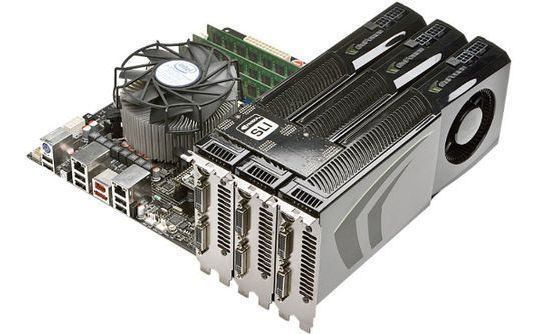SLI (Scalable Link Interface)
SLI (Scalable Link Interface) is a multi-GPU parallel processing application for computer graphic cards developed by Nvidia. Simply, it allows two or more video graphic cards to be connected together for one output. The technology was formerly used by 3dfx Interactive with the Voodoo2 video cards as the Scan Line Interleave in the late 1990s. Later when Nvidia bought out 3dfx Interactive, SLI was not used. However, starting in 2004, SLI was renamed as the Scalable Link Interface and was planned to be widely used with computers with a PCI Express (PCIe) bus system. It is quite similar to the rival company’s technology, ATI’s CrossFire.
Behind the Technology
The SLI technology allows two or more graphics processing units (GPUs) to collectively work on a 3D rendering request. Usually it is preferable to use the same type of video graphic cards on the multiple (usually two) PCI-Express x16 slots set in a master-slave configuration. When a 3D rendering request is queued, the master card will do half of the work and the slave card will do half of the work. When the 3D rendering work is done, the slave will send the finished product through the SLI Bridge to the master card, which will then complete the picture by putting the two parts together and then displaying it on the monitor screen.
With low-end to decent mid-range graphic cards (such as the 7100GS), an SLI bridge is not required, as Nvidia’s Forceware drivers can handle it. However, this is because these lower end graphic cards do not use as much bandwidth, thus, allowing the motherboard to be able to handle it on its own. Conversely, with higher end graphic cards, the SLI bridge is a must, as it can reduce the bandwidth constraints and can also directly send information between two graphic cards. If an SLI bridge is not used with the higher end cards, their full capabilities may not be used during processing.

Types of Rendering
SLI has a couple ways to render along with an anti-aliasing method. This is crucial as this is what determines how the workload is split between the graphic cards.
- Alternate Frame Rendering (AFR): This is a rendering configuration where each GPU will render an entire frame. Basically, one would render the odd frames while the other would render the even frames. So, when the slave is done with its work, it will send it via the SLI bridge to the master, which will complete the work and display it. This usually takes half the rendering time, allowing the performance to be up to double what it normally is.
- Split Frame Rendering (SFR): This rendering configuration will first inspect the request and try to divide the work into halves for both the GPUs to work with. This is done by splitting the frame horizontally.
- SLI Antialiasing: This is a straightforward splitting of the workload (with antialiasing) between the two graphic cards, while offering a better quality picture. Unlike the expected half-half, one graphic card will work on a slightly offset area (such as down and right) while the other one will work with the other offset area. This allows a clearer image to be displayed in place for a better performance. Usually this configuration allows antialiasing options such as SLI 8X, SLI 16X and SLI 32X.
Early Days of the SLI
In its early days (after Nvidia bought out 3dfx Interactive), there was a limited amount of support for the SLI by the motherboards. So, usually, an external card (that came with the motherboard) that would fit between the two PCI-Express x16 slots was necessary. This card, depending on how it was slotted in, would indicate to the motherboard that the primary graphic card slot need to be channeled into all 16 lanes of the PCI-Express x16 slots or be split equally (lane wise) between the two slots, due to the limitations f the motherboards at the time. Now, most motherboards support SLI right out of the box, allowing both video graphic cards to use all 16 lanes in both of their respective PCI-Express x16 slots.
Downsides with SLIs
- A single high-end graphic card often performs better than two mediocre graphic cards. Therefore, SLI does not always mean the better option.
- The two cards used must be of the same GPU model, even if the default clock speeds, BIOS revisions, and memory sizes may be different. Note that the higher card will run at the specs of the lower card.
- In some instances with the SLI AFR mode, vertical synchronization and triple buffering may not work.
- Although hacks can be used so that SLI will work with other motherboards, the only officially SLI compatible motherboards are those with an nForce4, nForce 500, nForce 600, or nForce 700 SLI chipset. It is designed so that the SLI will not function at its best when used in motherboards without the mentioned chipsets.
- As is the same with Nvidia’s SLI and ATI’s CrossFire, the multi-GPU technology does not always produce a better result. At times, framerates can also be dropped, as experienced from test results showing that performances do drop when a program is run at a low resolution.
- With SLI configurations, only a single digital video output is possible. This means that Dualview (for Microsoft Windows) and TwinView (for Linux) is not possible. Nonetheless, multiple monitors can still be used when used with third party devices.


Comments - No Responses to “SLI (Scalable Link Interface)”
Sorry but comments are closed at this time.